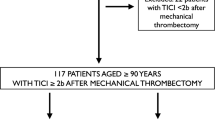Abstract
Background
Clazosentan, an endothelin-1 receptor antagonist, has been shown to prevent the development of large vessel angiographic vasospasm after aneurysmal subarachnoid hemorrhage. We hypothesized that clazosentan can improve cerebral perfusion for territories affected by angiographically confirmed vasospasm.
Methods
The REVERSE study (REversal of Vasospasm with clazosEntan post-aneuRysmal Subarachnoid hEmorrhage) was a prospective multicenter open-label pilot study of adult patients with aneurysmal subarachnoid hemorrhage who received intravenous clazosentan after developing moderate to severe angiographic vasospasm. Using the radiographic data from the REVERSE study and additional retrospective radiographic data from our tertiary medical center, we compared the impact of intravenous clazosentan with intraarterial vasodilator therapy (medical standard of care) on vasospasm reversal using time to peak perfusion (TTPP; the time interval between the peak opacification of contrast dye in the main artery supplying an anatomically defined territory and the parenchymal phase when the dye is diffusely present in the brain parenchyma).
Results
Both intravenous clazosentan (n = 7 vessels) and intraarterial vasodilator therapy (n = 11 vessels) resulted in a statistically significant improvement in TTPP at 24 h post intervention, when compared with the TTPP just prior to intervention for territories with angiographically confirmed severe vasospasm in the proximal arteries at baseline (linear mixed-effect model, p = 0.02). The clazosentan and intraarterial vasodilator therapy groups exhibited no statistically significant interaction term [time x treatment group (medical standard of care vs. clazosentan)] in our model (p = 0.71), suggesting similar temporal course of two therapies.
Conclusions
In our small pilot study, intravenous clazosentan administered for at least 24 h had an effect comparable with that of intraarterial vasodilator therapy in reversing angiographically confirmed severe vasospasm. Our results may indicate that clazosentan, in an appropriately selected patient cohort, could offer a noninvasive approach for alleviating vasospasm.



Similar content being viewed by others
References
Chow M, Dumont AS, Kassell NF, et al. Endothelin receptor antagonists and cerebral vasospasm: an update. Neurosurgery. 2002;51(6):1333–42.
MacDonald RL, Kassell NF, Mayer S, et al. Clazosentan to overcome neurological ischemia and infarction occurring after subarachnoid hemorrhage (CONSCIOUS-1): randomized, double-blind, placebo-controlled phase 2 dose-finding trial. Stroke. 2008;39(11):3015–21.
Vajkoczy P, Meyer B, Weidauer S, et al. Clazosentan (AXV-034343), a selective endothelin A receptor antagonist, in the prevention of cerebral vasospasm following severe aneurysmal subarachnoid hemorrhage: results of a randomized, double-blind, placebo-controlled, multicenter phase IIa study. J Neurosurg. 2005;103(1):9–17.
Higashida RT, Bruder N, Gupta R, et al. Reversal of vasospasm with clazosentan after aneurysmal subarachnoid hemorrhage: a pilot study. World Neurosurg. 2019;128:e639–48.
Donaldson C, O’Neill AH, Slater L-A, Chong W, Lai LT, Chandra RV. Feasibility of real-time angiographic perfusion imaging in the treatment of cerebral vasospasm. Interv Neurol. 2017;6(3–4):163–9.
R Core Team, R Foundation for Statistical Computing. R: A Language and Environment for Statistical Computing. 2019. http://www.r-project.org/.
Satterthwaite FE. An approximate distribution of estimates of variance components. Biometrics Bull. 1946;2(6):110.
Besheli LD, Tan CO, Bell DL, Hirsch JA, Gupta R. Temporal evolution of vasospasm and clinical outcome after intra-arterial vasodilator therapy in patients with aneurysmal subarachnoid hemorrhage. PLoS ONE. 2017;12(3):1–12.
Hattingen E, Blasel S, Dettmann E, et al. Perfusion-weighted MRI to evaluate cerebral autoregulation in aneurysmal subarachnoid haemorrhage. Neuroradiology. 2008;50(11):929–38.
Weidauer S, Vatter H, Beck J, et al. Focal laminar cortical infarcts following aneurysmal subarachnoid haemorrhage. Neuroradiology. 2008;50(1):1–8.
Weidauer S, Lanfermann H, Raabe A, Zanella F, Seifert V, Beck J. Impairment of cerebral perfusion and infarct patterns attributable to vasospasm after aneurysmal subarachnoid hemorrhage: a prospective MRI and DSA Study. Stroke. 2007;38(6):1831–6.
Yundt KD, Grubb RL, Diringer MN, Powers WJ. Autoregulatory vasodilation of parenchymal vessels is impaired during cerebral vasospasm. J Cereb Blood Flow Metab. 1998;18(4):419–24.
Ohkuma H, Manabe H, Tanaka M, Suzuki S. Impact of cerebral microcirculatory changes on cerebral blood flow during cerebral vasospasm after aneurysmal subarachnoid hemorrhage. Stroke. 2000;31:1621–7.
MacDonald RL, Higashida RT, Keller E, et al. Randomized trial of clazosentan in patients with aneurysmal subarachnoid hemorrhage undergoing endovascular coiling. Stroke. 2012;43(6):1463–9.
Acknowledgements
We would like to acknowledge Angelina Marr and Sébastien Roux of Idorsia Pharmaceuticals Ltd. for their courtesy review, advice, and input on this manuscript.
Author information
Authors and Affiliations
Contributions
RG conceived and designed the study. AL collected the data. RG monitored data collection. AL, JV, CT, RG, JH, and SW analyzed the data. CT provided the statistical analysis of the data. TLM, SW, AL, RG, and CT made contributions to interpretation of the data. AL drafted the article. All authors provided critical feedback and revisions to the article. All parties interested in data sharing may contact RG. All authors approved the final manuscript.
Corresponding author
Ethics declarations
Source of Support
This research has not received any specific grant from any funding agency in the public, commercial or not-for-profit sectors.
Conflict of interest
RG and SW have been consultants and scientific advisors for Actelion Pharmaceuticals Ltd and Idorsia Pharmaceuticals Ltd and have received consulting fees. COT has been a consultant for Lokavant Inc and has received consulting fees. RG, SW, and JH served as members of the independent review committee on the REVERSE study.
Ethical Approval/Informed Consent
Ethical approval was obtained from the Partners Human Research Committee, Boston, USA. Reference number: 2014P002368.
Additional information
Publisher's Note
Springer Nature remains neutral with regard to jurisdictional claims in published maps and institutional affiliations.
Rights and permissions
About this article
Cite this article
Lai, A., Tan, C.O., Vranic, J. et al. Clazosentan for Improvement of Time to Peak Perfusion in Patients with Angiographically Confirmed Severe Vasospasm. Neurocrit Care 36, 240–247 (2022). https://doi.org/10.1007/s12028-021-01291-4
Received:
Accepted:
Published:
Issue Date:
DOI: https://doi.org/10.1007/s12028-021-01291-4




